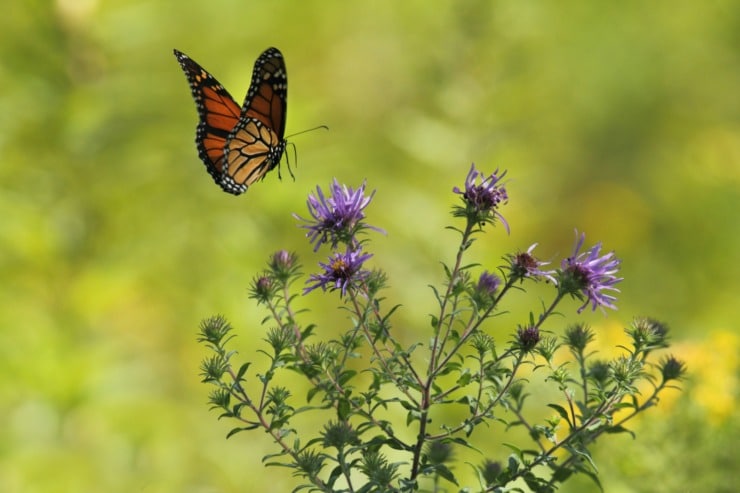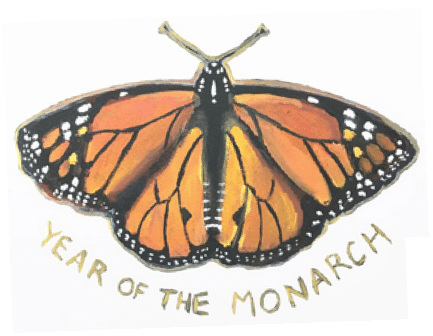Moving forward with hope and more milkweed
I don’t have a green thumb. My plant care skills aren’t necessarily a death sentence (not to be morbid), but probably provide only a 50% chance of survival. Some years ago, I was given a money plant—Golden Pothos—and assured that it would need nothing more than occasional watering. Unfortunately, it’s now on its last legs. On the other hand, I have a tropical curry leaf plant—also a gift—that is thriving beyond reason despite its decidedly non-tropical location (I live in Indiana.)
I suppose my thumb is less green than . . . chartreuse.
Nevertheless, my thumb and I were inspired by Tweetspeak’s declaration of the Year of the Monarch to plant milkweed in my yard and contribute to this butterfly’s diminishing habitat. The milkweed varietal I chose—butterfly weed—took surprisingly well to the soil, bloomed sunset-orange in late summer, and then morphed into intriguing green pods in early fall.
I crossed my fingers, hoping and checking for flashes of brilliant yellow and black—monarch caterpillars. Though none appeared, I was undeterred in making grand milkweed plans. I imagined this part of my yard thriving with blossoms and pods and caterpillars next year. I imagined adding more pollinator plants—maybe wild poppies and black eyed susans—and I pored over the Prairie Moon Nursery catalog. Surely it was only a matter of time before butterflies and honeybees learned of my homegrown waystation.
And in the meantime, I would prepare my milkweed plants for winter per my online research, leaving 10 inches of stalks protruding to keep a marker of their location and provide a winter habitat for birds and pollinators.
Then I made a mistake.
I have a large yard and no intention of managing it myself (please refer to the chartreuse thumb discussion above), and, due to a miscommunication, the person helping me included my milkweed in his general fall cleanup and cutdown. One day, I returned home to find the milkweed pulled up, without a single stalk in sight. In fact, mulch covered the entire area, as though it had never existed.
While I hoped some seeds of this perennial possibly remained in the soil and might reemerge at the right time, I also felt terribly frustrated. This was the Year of the Monarch, after all, and I wanted to report my positive actions to benefit an exquisite endangered species, one about which I’ve grown to care deeply. My embarrassment at my failure combined with my tendencies toward self-flagellation to make a toxic cocktail.
I’m no gardener, I thought. Why am I trying to do this? Such a small amount of milkweed can’t possibly matter.
***
West Park in Carmel, Indiana, was established just a year before we moved to a nearby neighborhood. At the time, with young kids, I was mostly drawn to the jungle gyms and picnic spots, but as years passed, I realized something more was happening in this public space.
The pond at the border was attracting a number of local birds and frogs, and their trills and croaks were becoming part of the park’s background noise, blending with children’s squeals and shouts. Additionally, the foliage lining the park’s walking paths was gradually becoming wilder and less cultivated and was buzzing with insects almost year-round.
I was accustomed to wildness in nature reserves and forests, but not in parks, which I associated with cultivated grounds and trimmed landscaping. It was some time before I read the signage and realized that West Park was trying to reclaim Indiana’s native prairie land, that there were purposeful designs and efforts in motion.
Recently, I spoke with Michael Allen, the Carmel Clay Director of Parks and Natural Resources, who has been part of West Park’s development and maintenance since 2015. According to Allen, West Park was deliberately planned to exclude monocultures and invasive species and to shore up native plants in a sustainable manner. After all, Allen said, ecosystems regenerate themselves only in the presence of healthy biodiversity.
Over the years, that biodiversity had been growing before my eyes and under my nose, and now, the park is flourishing with native species. But Allen related the difficulty of the park’s early years as the staff labored to reclaim prairie from what had essentially become agricultural land. Many native seeds didn’t sprout, or failed to thrive in the areas in which they were planted, and it took years for significant patches of prairie to take root and flourish. Even now, active management is required to reduce the pressure from invasive species.
As I listened to the director, I marveled at the city’s and park staff’s long-term plans and efforts that had resulted in such lush biodiversity—including monarch butterflies, according to Allen. (I resolved to pay better attention during my visits!)
Even as I admired the project, though, my embarrassment flared again, this time for a different reason. How easily I’d been frustrated by my first attempt to plant milkweed! And how foolish my pollinator garden dreams seemed given my minimal efforts to date. After all, so much work had been done at West Park, for so many years.
I thought of my extraordinary friend, Jessica Reed, a professor and fellow poet, whose home I’d recently visited. Jessica and her husband relocated to a rural area of Indiana and refitted a house with geothermal heating and cooling, solar panels, metal roofing, and other eco-friendly features. Over the years, they have reclaimed acres of prairie surrounding their home, and now grow produce, save seeds, compost waste, and raise chickens. I’m always in awe as I listen to her relate her journey, and I feel lucky to have a friend with such integrity, who has worked diligently to align her life to her environmental values.
But, boy oh boy, how can I match efforts like these?
This time, though, when my self-flagellation began, I was able to stop for a moment and breathe. As reluctant as I felt to do so, I extended myself a bit of grace.
Perhaps I didn’t need to belittle my own small steps and tiny nudges forward.
I recalled my semi-revulsion at the caterpillar pod that had showed up on my doorstep the previous year, and my semi-disgust at the pupation happening in my home. From that starting point—nothing short of entomophobia—I’d begun to learn about monarch butterflies and other pollinators, to notice them in the world, and even, believe it or not, to seek them out.
From a person who’d scrupulously avoided insects (and involuntarily shrieked in their presence), I’d become one who, despite a chartreuse thumb, wanted to bring pollinators to her own yard, one who’d even taken action to draw them closer. Why was I minimizing those efforts?
Indeed, Michael Allen encourages people not to underestimate the importance of pollinator- friendly yards, which he calls “a wonderful opportunity.” For those who are willing, he says, there is plenty of space both to play and to plant a few native species.
In fact, native plant seed packets are often free and easy to find, for example, at local libraries. In just the past year, I’ve been offered seed packets from Keep Indianapolis Beautiful here in town, the Lady Bird Johnson Wildflower Center in Austin, and the Carter Center in Atlanta. (Note: please plant only what’s native to your geographical area.)
In short, each yard is a small step toward self-sustaining biodiversity, habitat for wildlife, and a healing earth. During my Austin trip, I purchased beautiful greeting cards that actually contain seeds within their fibers—bird’s eye, clarkia, black eyed susan, snapdragon, and more. The cards can be planted directly in soil by the recipients. Apropos of this discussion, the company producing the cards is called Small Victories.
It’s still winter, but I’m imagining that a milkweed seed or two may have survived the fall reaping, that they are now drowsing through the cold, readying themselves to sprout and grow again. If not, though, I can still outpicture moving forward, armed with hope and more milkweed. I am learning that each seed matters. My mindset matters. My effort matters.
It matters.
Photo by Gary Bendig on Unsplash. Post by Dheepa R. Maturi.
- Morphing: Lessons from the Year of the Monarch - October 23, 2024
- Year of the Monarch: Butterfly Kisses—A Romantic Comedy - August 7, 2024
- Year of the Monarch: In Sync — a Communal Poem for the Monarch Butterfly - April 11, 2024


L.L. Barkat says
A chartreuse thumb… I have one too! (best suited to growing wild things that need no care from me 😉 ) (Your choice of color made me laugh, btw)
And then… the momentum of this piece. Oh, Dheepa. By the time I reached the end, tears were brimming. Yes, what we do matters. And you? Your words are a form of planting, extending small efforts into larger grounds. Thank you for putting them together and handing us the amazing bouquet of solidarity, vision, and hope.
Dheepa R. Maturi says
Lol, somehow “chartreuse” seemed like the accurate shade!
Thank you for pointing out this intriguing dynamic—when problems are so large, so beyond-human in scope, then a tiny little action reduces that nauseating feeling of overwhelm. I don’t know how, but it does!
Rammohan says
Oh Dheepa,
How true “. The eyes don’t see what the mind doesn’t know”. What appeared to be trivial things happening around us , has indeed profound impact. But we need someone like you to bring to our attention.
Even as far fetched as Monarchs!
Thanks for making us to be more observant.
Rammohan
Dheepa R. Maturi says
Yes, it’s an interesting mindset shift, isn’t it? It’s so easy to ignore a tiny thing, but when you look–really look–at it, there is so much detail and intricacy to experience! Thank you so much for reading!